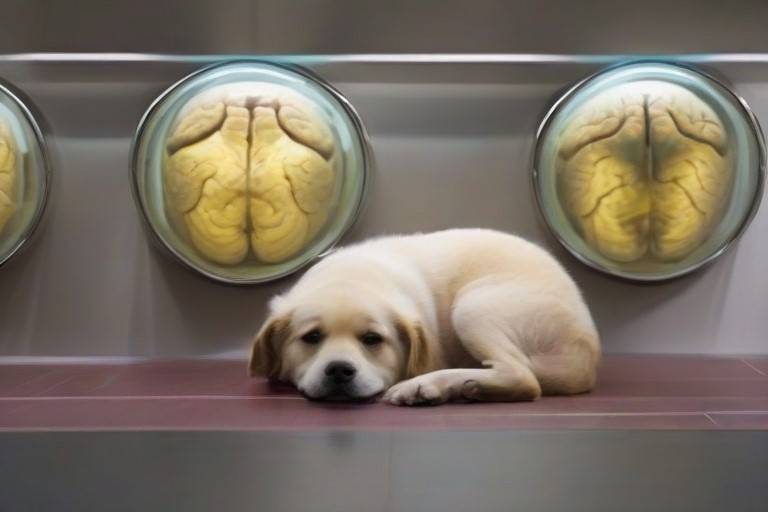Explore the subtle signs of brain tumor in dogs. Our guide provides insights into canine health, helping you recognize and address potential symptoms.
Key Takeaways on Signs of Brain Tumor in Dogs

- Common early symptoms include seizures, pacing and circling vision problems, and abnormal behaviours.
- Later-stage signs involve loss of balance and motor skills, lethargy, and vomiting.
- Brain tumours often progress rapidly once symptoms appear.
- Getting a veterinary diagnosis is essential upon noticing changes.
What Are Some Early Signs of Brain Tumor in Dogs?
Brain tumours are, unfortunately, a common occurrence in older dogs. According to the American Veterinary Medical Association, over 2.5% of dogs develop brain tumours annually. The tricky thing is that signs of a brain tumour in dogs can sometimes be subtle in the early stages. However, dog owners must catch symptoms as early as possible, as these growths develop aggressively. Getting a prompt veterinary diagnosis and beginning treatment measures can significantly improve prognosis.
Some early subtle signs of a brain tumour in dogs include:

- Seizures – These may start sporadically as focal seizures affecting one body area. With time, they often become more severe and generalized.
- Pacing, circling, and getting stuck in corners – This demonstrates spatial disorientation and issues with balance.
- Vision problems – Bumping into walls, furniture, or stigma from losing eyesight.
- Personality changes – Uncharacteristic aggression, restlessness, anxiety.
- Excessive thirst/urination – This emerges when pressure from the tumour begins impairing hormonal regulation.
These early symptoms originate from intracranial pressure, inflammation, and tissue damage caused by the developing tumour irritating the nearby brain tissue. Catching subtle shifts in behaviour and seizures early is critical.
What Are Some More Advanced Signs of Brain Tumor in Dogs?

As the brain tumour progresses in dogs, it causes worsening damage and pressure in the brain. This leads to some more apparent neurological impairment and non-specific systemic signs. Later-stage signs of a brain tumour in dogs involve:
- Worsening disorientation, stumbling, running into objects
- Head tilt from the imbalance
- Non-seeing eye with pupil dilation
- Listlessness, lethargy, reluctance to play/go on walks
- Persistent vomiting or retching
- Occasional fainting or collapse
These later changes result from the tumor affecting various parts of the brain or blocking the flow of cerebrospinal fluid. Left untreated, a vet may diagnose the tumour as grade III or higher.
| Early Stage Signs | Later Stage Signs |
| Seizures | Worsening spatial disorientation/balance issues |
| Pacing and circling | Head tilt |
| Vision problems | Enlarged non-reactive pupil |
| Abnormal behaviors | Lethargy, loss of interest in play |
| Increased thirst/urination | Vomiting |
| Fainting or collapse |
As evident from this table outlining the progression, Signs of brain tumor in dogs tend to evolve rapidly, from subtle symptoms initially to more intense impairment later as they grow and infiltrate. Getting ahead of the tumor growth curve with an early veterinary workup gives a dog the best odds of survival and maintaining quality of life. Researchers estimate dogs’ average survival at around 400 days following a brain tumor diagnosis. However, early intervention, treatment measures for the tumour, and secondary effects may prolong lifespan.
Risk Factors – What Dogs Tend to Develop Brain Tumor?
Certain types of dogs are more likely to suffer from signs of Brain Tumor in dogs. Understanding risk factors makes owners aware of what health changes to watch for. Dogs prone to brain tumours include:
- Older dogs – The average age at diagnosis is around 11 years
- Brachycephalic breeds – Boxers, Boston terriers, bulldogs
- Certain purebreds – Scottish terriers, golden, and Labrador retrievers
The mechanism speculated behind purebreds’ tendencies stems back to closed gene pools and potential genetic components underlying or triggering tumour formation.
For older dogs, the accumulation of mutations and growth errors in aging stem cells eventually leads them to increase abnormally as cancer cells. Brain tumours become very common in senior dogs, similar to people. Spotting worrisome signs early and confirming diagnosis through advanced imaging and biopsy allows for the best outlook.
Getting a Diagnosis – Next Steps After Recognizing Symptoms
The tricky aspect around signs of brain tumor in Dogs involves the difficulty of confirming a diagnosis. Many early symptoms emulate other neurological conditions like vestibular syndrome or even poisoning. Once a dog owner notes any behavioural shifts, seizures, pacing, or vision issues, however subtle, scheduling a veterinary exam immediately becomes essential.
To evaluate potential brain tumor in dogs, vets will perform a complete physical check for any suspicious pain reactions around the head or neck. They’ll also conduct a neurologic exam assessing reflexes and response in all four limbs, check eye health for pupil dilation differences, and evaluate average balance/ability to walk.
From here, confirming a diagnosis requires imaging tests like MRI or CT scans. These allow detailed visualization of any abnormal intracranial masses. The images then assist the specialist in surgical biopsy sample extraction to analyze cells’ appearance microscopically. Only after thorough preparations would a vet decisively diagnose a brain tumor.
What Are the Most Common Types of Signs of Brain Tumor in Dogs?
Over 120 cancerous and non-cancerous types of brain tumors exist, affecting dogs. The most frequent categories include:
- Meningiomas – These derive from the meninges membranes enveloping the nervous system. They account for roughly 41% of canine brain tumors.
- Gliomas – Gliomas emerge directly from the glial support cells of the central nervous system. These make up about 35% of diagnoses.
- Lymphomas – Lymphocytic cancers sometimes infiltrate the brain, causing around 13% of tumors.
Other less common types include pituitary adenomas, medulloblastomas, schwannomas, and metastatic cancers spreading from other sites like hemangiosarcomas or melanomas. Each tumor type carries its own average survival time and treatment approach. Meningiomas tend to have the most positive prognoses and durable responses to treatments like surgery, radiation therapy, and chemotherapy drugs.
Are Brain Tumors in Dogs Treatable? What Are the Options?
Historically, veterinarians viewed signs of brain tumors in dogs as non-treatable. However, modern advancements now provide dogs with several medical and surgical options that can extend lives for months to years. These include:
- Surgical extraction – With meningiomas and certain other tumor types/locations, surgeons can remove the mass. Advanced techniques like fluorescence guidance improve precision.
- Radiation-focused, high-energy beams help destroy tumor tissue and suppress regrowth. Requires anesthesia and several sessions.
- Steroids – Powerful anti-inflammatories reduce swelling around the tumor site quickly.
- Chemotherapy – Various drugs that target cell processes driving tumor growth and spread are now available.
- Holistic – Some evidence exists supporting nutritional and plant-based supplements delaying tumor progression.
The prognosis following treatment greatly depends on the tumor type identified, its biological aggression, location, size, if metastatic, and how advanced at the time of diagnosis. Veterinary oncologists determine the best-tailored protocol for each dog. Even in advanced cases with lower survival estimates, treatment can significantly improve a dog’s comfort levels and restore neurological function for some time. Ultimately, quality time takes priority over quantity.
Monitoring At-Home – What to Look for After a Diagnosis?
The course of treatment affects each dog differently. After a brain tumor diagnosis, owners play a pivotal role in monitoring their pet’s progress or decline at home. You know your dog’s normal baseline best. Watch for:
- Appetite changes – Does your dog show interest at mealtimes? Any vomiting?
- Energy levels – Does your dog still want to play and go on walks?
- Seizures – Track any worsening number or durations.
- Vision or hearing – Does your dog seem more confused or bump into objects? Failure to respond to sounds/cues?
- Balance/coordination – Increase in stumbling or falling over? Head tilt?
- Mental status – Is your dog still eager to greet people and go places? Or depressed, reclusive acting?
Logging all these daily details provides critical information for vets managing cases. It also helps you make hard decisions on palliative care adjustments for comfort if your dog has difficult moments. Remember, even on hard days, the joy of each moment with your dog ultimately matters most.
Outlook for Signs of Brain Tumor in Dogs
Uncover vital signs of Brain Tumor in Dogs and act swiftly upon neurological symptoms. Minor shifts demand quick intervention to avoid losing treatment time as masses grow. Despite rapid tumor progression, evident signs mark a crucial window for diagnosis and impactful treatment. Modern options like surgery, chemotherapy, and immunotherapy offer extended life. Dog owners closely observe aging pets for neurologic changes; visit the vet promptly for early detection and better chances against aggressive tumors. Your proactive care can significantly impact your furry friend’s well-being. Beating aggressive tumors!
FAQs about Signs of Brain Tumor in Dogs
Here are the common questions about signs of Brain Tumor in dogs and the best answers for them.
What are the symptoms of a brain tumor in a dog?
Early on, you may notice subtle personality changes, seizures that come and go, pacing or walking in circles, or vision issues in your dog. As the tumor grows, symptoms often progress to loss of balance, lethargy, vomiting, or fainting. So, getting your vet’s advice is essential if you see any new neurological symptoms.
How long will a dog live with a brain tumor?
Every dog is different, but the average survival time after diagnosis is estimated to be around 400 days (over 13 months). Catching it early and starting treatment gives the best chances for more prolonged survival. Staying alert to symptoms, getting scans done promptly, and working closely with your vet team provide your buddy the best shot.
What are the first-stage symptoms of a brain tumor?
At first, brain tumors can cause occasional seizures, subtle vision problems, anxiety, restlessness, or other personality shifts, and episodes of circling/pacing. Since these changes are mild at the onset, it takes paying close attention daily to pick up on them. Logging any patterns helps your vet determine if imaging tests are needed to check for a tumor.
How do you know if your dog has a tumour?
If you notice the onset of new behaviours like seizures, disorientation, vision issues, personality changes, or other brain-related symptoms, schedule a vet exam right away. Your vet will check reflexes, balance, and vision and conduct a neuro exam. If the tumour is suspected, they’ll recommend scans like an MRI or CT to visualize the brain and look for masses. They may follow up with a biopsy to diagnose the tumor type before planning treatment.



